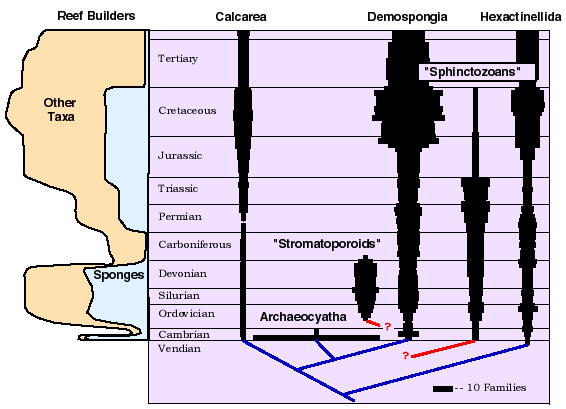



|
Porifera: Fossil Record
As the basal branch of the metazoans, poriferans have long been expected to be among the earliest undoubted animal fossils, those of the
Vendian
(or Ediacaran).
Until recently, however, no sponge body fossils had been identified or described from this fauna. In 1996, Gehling and Rigby identified and described
the first probable sponge, Paleophragmodictya, from the Ediacara of Australia.
Their specimens revealed a
reticulating net of spicules in the sponge body
wall, reminiscent of that seen in many
hexactinellid sponges. As seen in the figure above, sponges have been numerous in the seas since the Precambrian. Throughout most of the Phanerozoic, sponges have been major contributors to reef formation. A generalized cartoon of sponge contribution to the formation of reef carbonates is shown on the left of the figure above. It illustrates that today's situation, where scleractinian corals dominate, is more of an exception than a rule. Today, sponges are important ecological constituents of reef communities but they do not commonly contribute to the construction of reef frameworks as has been the case during most of their history. Sponges probably achieved their greatest diversity during the Cretaceous. It should be noted that charts such as these, known as spindle diagrams, do not account for the biases of the fossil record.
|

Sources:Gehling, J. G. and J. K. Rigby. 1996. "Long expected sponges from the neoproterozoic ediacara fauna of South Australia." Journal of Paleontology, 2: 185-195. Kauffman, E. G. and J. A. Fagerstrom. 1993. "The phanerozoic evolution of reef diversity." In Ricklefs, R. E. and D. Schluter (eds.), Species diversity in ecological communities: Historical and geographical perspectives. pp. 315-329. University of Chicago Press, Chicago. Rigby, J. K., G. E. Budd, R. A. Wood, and F. Debrenne. 1993. "Porifera." In M. J. Benton (ed.), The Fossil Record 2. pp. 71-99. Chapman & Hall, London. Rowland, S. M. and R. A. Gangloff. 1988. "Structure and Paleoecology of Lower Cambrian Reefs." Palaios, 3: 111-135. 

|